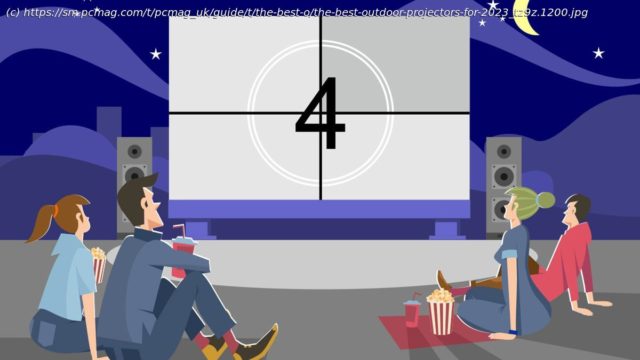Planning a movie night in your backyard? Invite some friends, grab the popcorn, and fire up your favorite flick with one of these top-pick projectors. Here’s how to choose the right one.
Now that you’ve seen our favorite tested picks above, you might have gathered from our assessments of each that minding the nuances when shopping for a projector can mean the difference between an A-list experience and a B-movie one.
Rule one is that every projector choice you make stems from a single decision: Do you want a permanent installation or an ad hoc setup? At one extreme, you can install all your projection equipment outdoors, fixed in place and weatherproofed: projector, video source, ancillary sound system, and screen. At the other, you can lug everything out to set up only when needed. In between, you might install, say, an outdoor screen and speakers, and carry the rest of the gear out and back as needed.
For permanent setups, only the projector, the video source, and additional audio components need to be protected from the weather, and that can be easy if you have, say, an enclosed Florida room with a sliding door to the outside. With everything set up, you can just open the door to let the projector light up the screen. For anything short of permanent setup, room-to-room portables let you minimize how much you need to carry back and forth before and after every movie night. But note that you might want to store even outdoor screens inside for winter or before a storm.
If you’re looking at a true, permanent outdoor installation of all the bits, we’d leave that approach to a local pro A/V installer, who can consult on your property’s specific needs for optimization, and be sure all the proper power wiring and the like is implemented safely. We’ll concentrate here on the DIY approach, in which you set up and break down all or most of your setup as needed.The Projected Image: How Big Should It Be?
Brightness requirements for a given projector are no different outdoors than indoors. It’s all about ambient light and the target image size (which we’ll get to shortly).
The ambient-light level outdoors after dark will likely be in the range between a dark room—if you’re way out in the country far from light pollution, and it’s a moonless night—and a family room at night with dim lighting. But don’t just assume that. Check your backyard at night, including on nights with a full moon, as well as when your closest neighbors have their backyard lights blazing. Then pick a projector that’s bright enough to stand up to the brightest light level you’ll use it under at the image size you want—an issue we discuss in our reviews.
You can watch a movie outdoors at night even on a pocket projector that puts out 100 lumens or less, but you’ll have to huddle around a small image to watch it. If you want a true movie-watching experience, you’ll want a minimum 80-inch screen size, and preferably larger.
For a comfortably watchable image at that size in dim lighting, you need a projector that puts out about 800 lumens—a level of brightness that rules out most small projectors, from pocket-size models to lightweight portable projectors.
Keep in mind, also, that the highest brightness most projectors can deliver comes at the cost of image quality. Put another way: The best-quality picture mode for any given projector is generally the dimmest. Whatever brightness you need has to be for the picture mode you want to use—which is often just 40% or 50% of the brightest choice.The Screen: Just Use the Garage Door? (Spoiler: You Can, But Don’t)
You can use just about any more-or-less flat surface for a screen, including a hanging bedsheet, a garage door, or a stucco wall of your house. Seamless photography paper and even white foam board can be good inexpensive screen materials. But for the best image, you absolutely want a dedicated projector screen, and should take a look at our tips for how to choose the right screen for your projector.
It’s easy to find outdoor frames for permanent, seasonal, and temporary setups, but the screen material is the more important part. The key choices are the same as for an indoor screen, starting with a spec called gain, which can increase image brightness.
A 1.0-gain screen reflects light equally in all directions over a 180-degree viewing angle. A higher gain reflects the light over a smaller angle, making the image brighter within that angle and dimmer outside of it. It’s essentially the same situation as with older LCD screens that have a sweet spot for viewing dead-on in front of them, but show degraded image quality outside of the viewing cone. For projector screens, a 1.2-gain would give you a peak 20% brighter image within the cone. The key thing is the angle, though: You’ll want to make sure nobody will be sitting so far to the side of the screen that they’ll be sitting outside the specified viewing angle.
If you’re screen-shopping, also look for the resolution the screen is designed for. Many are not meant for showing even 4K images, while some are designed for future-looking 8K output. Even if you’re using a mere 720p-resolution projector now, you might want a 4K-rated screen, so you can use the same screen over the lifetime of two or more projectors.
Finally, be sure the screen offers the right aspect ratio—typically, 16:9 for watching movies or TV shows. Common choices range from the almost square 4:3 ratio that used to be standard for TV to Cinemascope wide.What Is Throw Distance, and Why Does It Matter?
Throw distance is measured in feet or inches between the projector lens and your screen.






